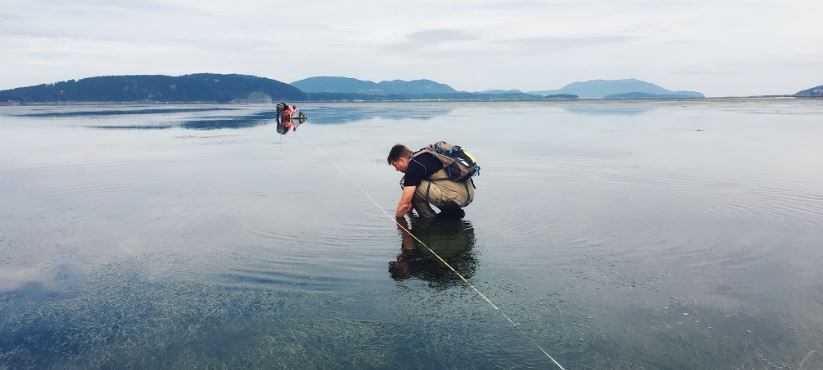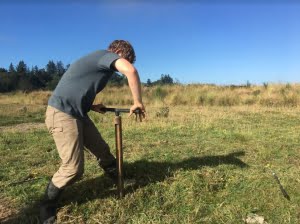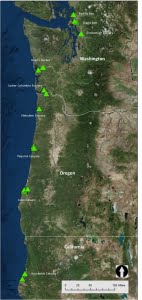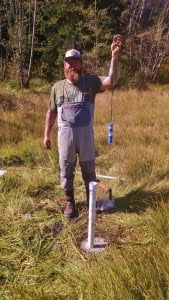
Do Pacific Northwest tidal wetlands do their part to moderate local effects of climate change?
By Craig Cornu, Estuary Technical Group, and Coordinator of the PNW Blue Carbon Working Group
November 2018
You may already know that the tidal wetlands you see fringing Oregon’s coastal bays are valued for their natural abilities to purify estuary waters, reduce storm flooding, and provide nurseries for great numbers of commercially- and recreationally-important fish and shellfish. But you may not know that tidal wetlands are also now recognized for their important role in pulling CO2 out of the earth’s atmosphere and permanently storing its carbon in wetland soils. Why is storing, or “sequestering,” CO2 so important? Because there’s too much CO2 in the atmosphere which is one of the principle drivers of climate change. Scientists, land managers, and policy makers are working hard to create efficient methods for reducing atmospheric CO2, and the conservation and restoration of tidal wetlands is one of the newest methods being explored.
The good news is that we in the Pacific Northwest (PNW), and at the Institute for Applied Ecology (IAE) and Estuary Technical Group (ETG), already know a great deal about conserving and restoring wetlands — we’ve been at it for some time now. The even better news is that carbon market registries are ready to facilitate the funding of those tidal wetland conservation and restoration projects that qualify as “blue carbon” projects to offset the CO2 emissions created by coal-fired power plants (for example) elsewhere. The not-so-great news is that we don’t have the information we need to determine if our PNW tidal wetland projects qualify as blue carbon projects.



Caption: Green triangles are the carbon stocks project’s 34 project sites which represent both least disturbed and disturbed examples of the major tidal wetland types found in the Pacific Northwest’s three geographically distinct regions, Puget Sound, Columbia River estuary, and outer coast estuaries.
Graphic: Craig Cornu
That’s where the research projects conducted by the PNW Blue Carbon Working Group come in. Led by a diverse group of researchers, land managers, carbon market investors, policy makers, and planners, and funded by the NOAA’s National Estuarine Research Reserve System (NERRS) Science Collaborative, our working group is conducting the first-ever comprehensive assessment of the carbon storing potential of PNW tidal wetlands. The project will also create a user-friendly database of regional blue carbon data easily accessible to all who need the information to develop blue carbon projects. This “carbon stocks” project is being administered through the IAE, and managed by the ETG’s Craig Cornu.
The carbon stocks project is entering its third and final year. During the 2017 and 2018 field seasons, we collected data at the project’s 34 sites, located from the Puget Sound’s Padilla Bay to the California coast’s Humboldt Bay, including Washington’s and Oregon’s outer coast and lower Columbia estuaries. Fieldwork has consisted of collecting a series of deep soil cores at each of the 34 sites (no small feat) and collecting “ecosystem driver” data (water level and water quality), critical for understanding the variations we’re sure to see in the soils data, at the same sites. Each deep soil core is analyzed for its carbon content which, when combined with each tidal wetland’s site attributes (e.g., wetland area, plant community, etc.) and ecosystem driver data, will enable us to estimate ranges of possible carbon storage values for specific PNW tidal wetland types. Knowing these values for tidal wetlands in our region is the first key step for qualifying projects as blue carbon projects, and ultimately for understanding how PNW tidal wetlands can collectively help address the local effects of climate change.
Craig Cornu has 20 years of experience with tidal wetland restoration and monitoring projects. He has advised others on similar projects, and is currently an IAE contractor, managing two regional blue carbon research projects as coordinator of the PNW Blue Carbon Working Group.


Restoration
Research
Education
Get Involved
Contact
Main Office:
4950 SW Hout Street
Corvallis, OR 97333-9598
541-753-3099
[email protected]
Southwest Office:
1850 Old Pecos Trail, Suite I
Santa Fe, NM 87505
[email protected]
© 2024 Institute for Applied Ecology | Privacy Policy